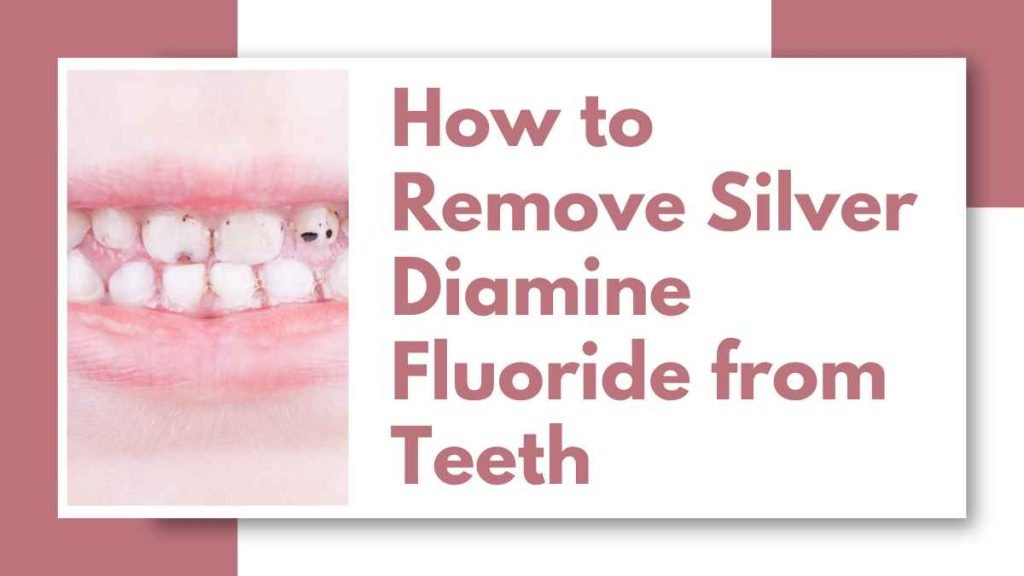How to Remove Silver Diamine Fluoride from Teeth! Hey there! Are you tired of that persistent silver diamine fluoride stain on your teeth? Fret not, because you’re in the right place! In this comprehensive guide, we will explore How to Remove Silver Diamine Fluoride from Teeth. Here we’ll dive deep into the world of silver diamine fluoride, understanding its effects, and most importantly, discovering effective ways to remove it from your precious pearly whites. Let’s embark on this journey to a brighter smile together!
Table of Contents
What is Silver Diamine Fluoride?
Before we delve into removal techniques, let’s understand what silver diamine fluoride (SDF) really is. SDF is a liquid substance containing silver, fluoride, and ammonia. Dentists often use it to treat tooth sensitivity and cavities. However, one common side effect is the unsightly black stain it leaves on teeth, causing concern among patients.
How to Remove Silver Diamine Fluoride from Teeth: A Step-by-Step Guide
Here you can checkout the step-by-step guide about How to Remove Silver Diamine Fluoride from Teeth:
Total Time: 10 minutes
Consult Your Dentist
The first and foremost step is to consult your dentist. They can evaluate the stain’s intensity and recommend the best removal method tailored to your specific case.
Professional Dental Cleaning
Professional dental cleaning by a hygienist or dentist can effectively remove surface stains, including those caused by SDF. They use specialized tools and techniques to polish your teeth, leaving them gleaming and stain-free.
Microabrasion
Microabrasion involves removing a thin layer of enamel, including the stained portion. This technique, performed by a dentist, helps eliminate surface stains and improve the overall appearance of your teeth.
Tooth Whitening Procedures
Tooth whitening procedures, like in-office bleaching or take-home whitening kits prescribed by dentists, can lighten the SDF stain. These procedures use peroxide-based solutions to break down the stains, revealing a brighter smile.
Veneers or Crowns
For severe stains that are resistant to other removal methods, dentists might recommend veneers or crowns. These are customized coverings placed over the teeth, concealing stains and giving you a flawless smile.
What Causes Silver Diamine Fluoride Stains on Teeth?
Understanding the causes is crucial in preventing future stains. The primary reason for SDF stains is the reaction between silver ions in the solution and organic matter in the tooth. Factors like poor oral hygiene, excessive consumption of staining foods and drinks, and smoking can exacerbate these stains.

Alternative Methods for Silver Diamine Fluoride Removal
Apart from professional treatments, there are a few natural and home-based remedies you can try:
Oil Pulling
Oil pulling with coconut or sesame oil is believed to remove toxins from the mouth, potentially reducing surface stains, including those caused by SDF.
Baking Soda Paste
A paste made from baking soda and water acts as a mild abrasive, aiding in stain removal. Gently brush your teeth with this paste to diminish surface stains over time.
Activated Charcoal
Activated charcoal is known for its absorbent properties. Brushing your teeth with activated charcoal powder can help lift surface stains, although its efficacy varies from person to person.
Common Mistakes to Avoid
- Overzealous Brushing: Brushing too hard in an attempt to remove stains can damage enamel, making teeth more susceptible to staining.
- Ignoring Professional Advice: Always follow your dentist’s recommendations. Ignoring professional guidance can worsen the situation.
- Delaying Treatment: Promptly addressing SDF stains prevents them from becoming deeply embedded, making removal easier.
Tips and Tricks for Effective Stain Removal
- Maintain Excellent Oral Hygiene: Regular brushing, flossing, and dental check-ups can prevent and minimize stains.
- Moderate Staining Foods: Limit consumption of tea, coffee, red wine, and berries, which can intensify tooth stains.
- Rinse After Consuming Staining Substances: Swishing water in your mouth after consuming staining substances helps wash away potential stains before they set in.
Facts About Silver Diamine Fluoride Stains
- Immediate Staining: SDF stains develop quickly after application, often within hours, making immediate action crucial for removal.
- Prevalence in Pediatric Dentistry: SDF is widely used in pediatric dentistry to treat cavities in children, especially those who can’t undergo traditional fillings due to age or behavior.
Conclusion
In conclusion of How to Remove Silver Diamine Fluoride from Teeth, dealing with silver diamine fluoride stains might seem daunting, but armed with the right knowledge, you can tackle this issue effectively. Remember, consulting your dentist is key, as they can guide you toward the most suitable removal method tailored to your needs. So, don’t let those stains hold you back; take action and reclaim your confident smile today! Here you can checkout that How to Remove Chlorhexidine Stains from Teeth.
FAQs About How to Remove Silver Diamine Fluoride from Teeth
Is silver diamine fluoride safe for dental use?
Yes, when used appropriately, silver diamine fluoride is considered safe. Dentists carefully apply it, minimizing the risk of adverse effects.
Can I prevent silver diamine fluoride stains?
While you can’t prevent the application of SDF for dental treatment, you can minimize its staining effects by maintaining good oral hygiene and avoiding staining substances.
Is microabrasion painful?
Microabrasion is generally painless, as dentists use local anesthesia to numb the teeth before the procedure.
How long do professional tooth whitening results last?
The longevity of professional tooth whitening results varies based on individual habits. With proper oral care and avoiding staining substances, results can last for several years.
Can activated charcoal damage tooth enamel?
Using activated charcoal in moderation is unlikely to damage enamel. However, excessive or aggressive use can be abrasive and harmful to enamel, so it’s essential to use it cautiously.
Will dental insurance cover the cost of stain removal procedures?
The coverage for stain removal procedures varies among dental insurance plans. It’s best to check with your insurance provider to understand your specific coverage.
Are veneers reversible?
Veneers are a permanent alteration to your teeth, as a small amount of enamel is usually removed to accommodate them. Reversal would involve replacing them with new restorations if desired.


